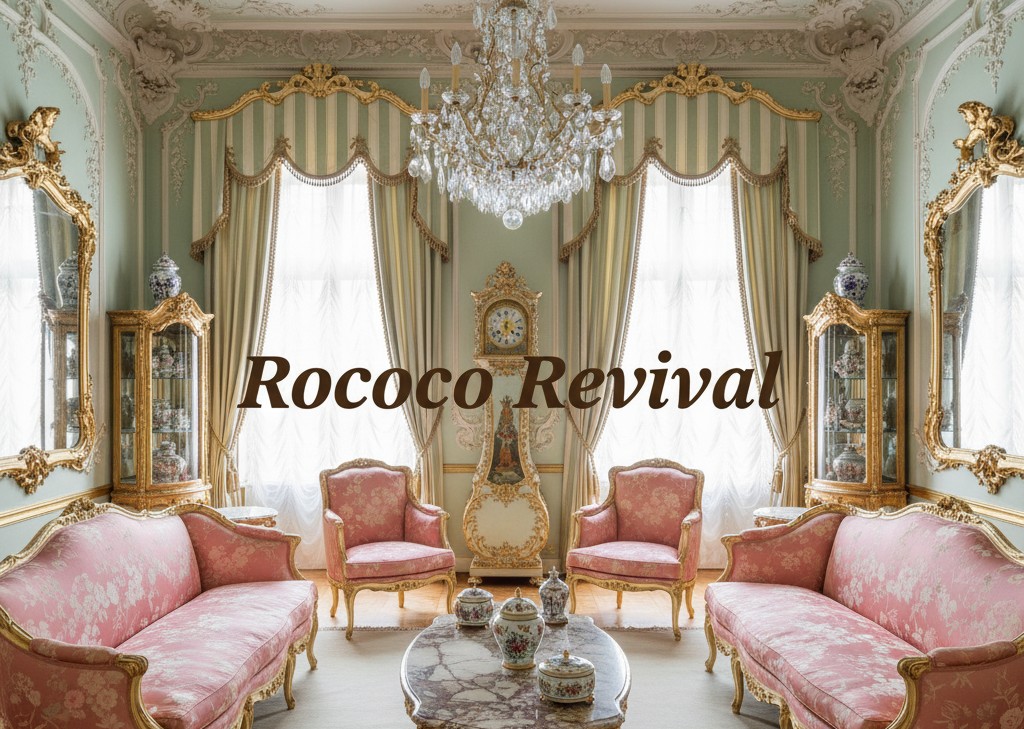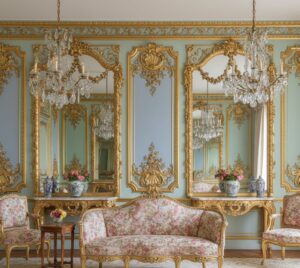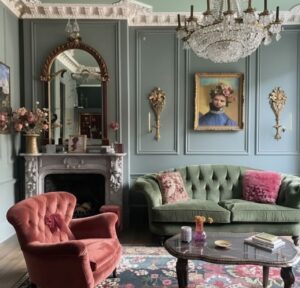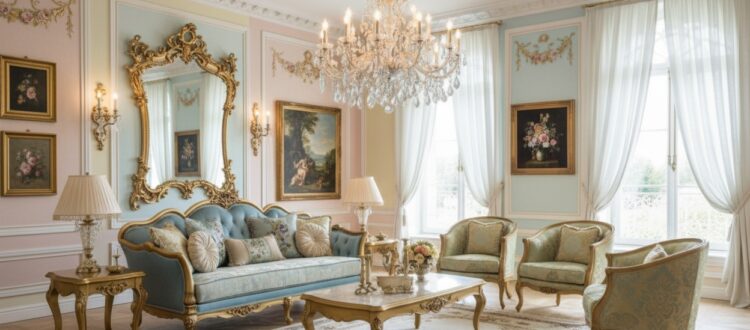The Art of Indulgence: Inside the Modern Rococo Comeback
Imagine this! You are walking into a home and you see exquisitely curved furniture, perhaps a sumptuous curved sofa set adorned with ornate carvings, delicate lighting casting a warm glow, and shimmering gilded finishes catching the eye. Everything feels romantic yet dramatic — gold accents, pastel hues, carved details dancing across the furniture. Yes, you have definitely walked into a Rococo style interior. It’s a space that whispers tales of elegance, romance, and a touch of playful extravagance.
As we approach the end of 2025, it’s undeniable: the Rococo Revival is not just a trend; it’s the major hit of the year and is here for a long, luxurious stay.
After years of minimalism, clean lines, and neutral tones, homeowners and designers alike are craving something more expressive, opulent, and joyful.
In this blog, we’ll explore what the Rococo style of interior is, the origins of Rococo, how it faded, and why it’s making a strong comeback.

Also Read: Beauty of Georgian Furniture
The Birth of Rococo: French Origins

The Rococo style emerged in early 18th-century France among the Parisian elites. Influenced heavily by Louis XV’s court, Rococo designs were full of asymmetry and fanciful motifs.
This style emerged as a playful evolution of the grand, dramatic Baroque style. Where Baroque favoured symmetry, dark tones, and power, Rococo went lighter, more romantic, and more personal.
The word Rococo comes from rocaille, referring to the shell and rock motifs that dominated the decorative arts of the time. Think of gilded frames curling like waves, walls dressed in pastel frescoes, and furniture adorned with intricate carvings inspired by nature — shells, flowers, vines, cherubs.
Key Features of Rococo Style Interiors:
- Asymmetrical designs with fluid, organic curves
- Pastel colour palettes: powder blue, soft pink, ivory, gold, and mint
- Ornate gilding and hand-carved details
- Floral and shell motifs
- Decorative mirrors and crystal lighting
- Luxurious fabrics — silks, brocades, and velvets
In short, Rococo furniture and decor celebrated beauty for beauty’s sake — elegance, softness, and fantasy.
Why Did Rococo Fade Away? The Tide Turns
Despite its initial popularity, Rococo’s reign was relatively short-lived. By the late 18th century, a new aesthetic philosophy, Neoclassicism, began to take hold.
Critique of Frivolity: As the Enlightenment era emphasised reason, order, and classical ideals, Rococo’s perceived “frivolity,” excessive ornamentation, and lack of serious subject matter came under fire.
Shift to Neoclassicism: Neoclassicism looked back to the perceived purity and grandeur of ancient Greece and Rome, favouring straight lines, strict symmetry, solemn themes, and moral seriousness.
Why Is Rococo Making a Comeback?

To understand the Rococo Revival, we need to look back at its origins.
When King Louis XIV — the “Sun King” — passed away, France shifted from the grandeur and discipline of Baroque to something softer and more playful. Power moved from the monarchy to the aristocracy, and with it came a new appetite for beauty, indulgence, and escapism. The upper class sought to distract from the social and political tension outside their gilded walls through art, design, and luxurious interiors.
Today, centuries later, the pattern repeats itself. We’re living through our own period of uncertainty and collective fatigue. After years of stress and restraint, people are gravitating toward decor that feels light, joyful, and self-expressive.
But this time, it’s not the aristocracy leading the change — it’s everyone else. The modern Rococo movement is driven by individuals who want their homes to feel comforting, romantic, and a little bit indulgent.
Why the revival?
- Reaction to minimalism: After years of pared-back, beige interiors, people are craving texture, colour, and personality.
- Nostalgia meets escapism: Rococo offers a dreamy, romantic aesthetic that feels like a fantasy escape from fast-paced modern life.
- Craftsmanship appreciation: In a world of mass production, the hand-carved detail of Rococo furniture feels luxurious and meaningful.
- Mix-and-match flexibility: The new Rococo style blends well with modern decor — think a gilded mirror above a minimalist console, or a curved sofa in a contemporary loft.
This “Modern Rococo” or “Rococo Revival” movement is not about recreating palaces — it’s about adding opulent details to everyday living.
Key Elements of Rococo Style Interiors
To master the Rococo Revival look, you need to understand what defines it. Here are the essential Rococo design elements to look for:
- Curves Everywhere
Curved furniture defines the Rococo aesthetic — cabriole legs on chairs, scrolling arms, curved mirrors, and serpentine consoles. The more organic the shape, the better.
- Pastel and Gold Colour Palettes
Rococo interiors favour soft hues — powder blue, blush pink, ivory, light green — accented with gilded gold or bronze. These tones make spaces feel warm, airy, and elegant.
- Gilded Details
From gold-leaf frames to ornate chandeliers, gilding is a hallmark of Rococo decor. Subtle metallic accents elevate even simple rooms.
- Floral and Nature Motifs
Nature played muse to Rococo artisans. Floral patterns, shell shapes, vines, and cherubs decorate everything from headboards to wall panels.
- Ornate Lighting
Crystal chandeliers, candelabras, and wall sconces create the romantic ambiance essential to Rococo-style interiors.
- Luxurious Fabrics
Velvet, silk, brocade, and damask bring tactile richness. Soft drapes and tufted upholstery add to the sense of comfort and charm.
Prominent Rococo Furniture Pieces That Define the Style
Certain furniture types instantly evoke Rococo design. Here are the standout Rococo furniture pieces worth knowing (and collecting):
- The Cabriole-Leg Armchair
One of the most iconic Rococo silhouettes, the Louis XV armchair features cabriole legs, curved arms, and delicate carvings. Upholstered in damask or velvet, it remains a centrepiece in Rococo-style interiors.
- The Bombe Chest
This curvaceous chest of drawers with bulging fronts and gilded handles epitomises Rococo craftsmanship. Perfect as an accent piece in bedrooms or entryways.
- The Console Table with Mirror
Often gilded and adorned with shell and floral motifs, the Rococo console pairs beautifully with a matching mirror — ideal for hallways or grand living rooms.
- The Chaise Longue
Graceful and inviting, the chaise longue embodies Rococo’s romantic flair. Place it near a window or dressing area for that Versailles-inspired charm.
- The Decorative Mirror
No Rococo room is complete without an ornate mirror. These pieces amplify light and add a touch of royal drama to walls.
- The Parlour Sofa
Curved, tufted, and elegant, the Rococo sofa brings instant sophistication to any living space — whether upholstered in pastel velvet or neutral linen.
How to Decorate Your Home in Rococo Style

- Start with Statement Pieces
Choose one or two Rococo furniture pieces — like a gilded mirror, curved armchair, or bombe chest — and let them anchor the space.
- Layer Soft Colours
Build your palette around ivory, blush, gold, and powder blue. Keep walls neutral to let ornate furniture and art stand out.
- Add Texture and Detail
Use fabrics like velvet, silk, and lace. Mix carved wood with smooth marble or glass for a tactile contrast.
- Play with Lighting
Install a crystal chandelier or vintage-style sconces to capture Rococo’s signature glow. Warm, diffused light enhances the romantic mood.
- Include Art and Accessories
Baroque paintings, gilded frames, porcelain figurines, and floral arrangements echo the spirit of the era.
- Blend Old with New
A modern Rococo interior doesn’t need to look historical. Combine ornate antiques with sleek contemporary furniture for a balanced, chic feel.
Why Rococo Still Captivates
The enduring allure of Rococo lies in its humanity — it’s decorative, emotional, and unapologetically beautiful. While minimalist design often speaks of restraint, Rococo celebrates joy, romance, and artistry.
Whether it’s a gilded mirror catching the afternoon light, a curved armchair inviting you to sit, or delicate carvings that tell a story, Rococo-style furniture transforms homes into experiences.
The Return of Romance
As 2025 closes, the Rococo Revival isn’t just a passing trend — it’s a cultural shift. It signals our renewed love for craftsmanship, individuality, and the art of living beautifully.
So, if your home feels too minimal, too modern, or simply missing that spark — maybe it’s time to add a little Rococo romance. A curve here, a gilded frame there, a chandelier that glows like a memory of Versailles.
After all, beauty never goes out of style — it just finds new ways to shine.






